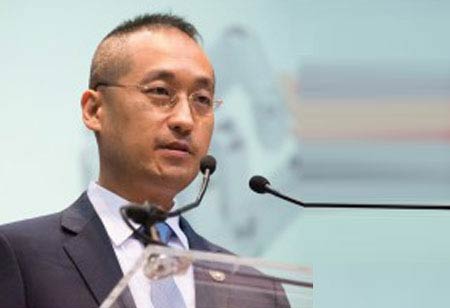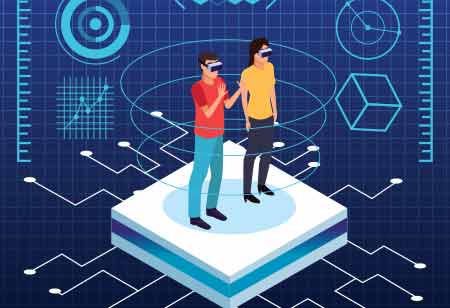THANK YOU FOR SUBSCRIBING

How Technological Convergence is Shaping the Future
Sokwoo Rhee, Corporate SVP for Innovation, LG Electronics

 Sokwoo Rhee, Corporate SVP for Innovation, LG Electronics
Sokwoo Rhee, Corporate SVP for Innovation, LG Electronics Technological convergence has become so prevalent that many people hardly register that the technology we use daily once was two or more unrelated products. The smartphone, the primary example of convergence, has spurred countless other examples of industries coming together to improve services for users. While people have come to know their devices as a one-stop shop for all communication and entertainment needs, the convergence of other technologies and industries brings new opportunities for innovation.
As technological convergence matures, we are seeing more innovative,impactful developments in artificial intelligence (AI), augmented reality (AR), virtual reality (VR), mixed reality (MR), and machine learning (ML)—transforming the future of healthcare, sustainability, and the workplace. These new areas of convergence hold the promise of killer applications that will change how we think about, interact with, and use technologies in our everyday life.
In recent news, ChatGPT has brought a whole new dimension to AI. While the debate continues on if, how and for what we should use AI, it is apparent that it has a part of our future life. As AIgrows, it will be prudent for people to be conscientious of how it is further improved to provide assistance to enhance everyday life. This also means when AI becomes more intelligent, the possibilities for new technology developments become vaster. The convergence of new devices will expand in the coming years due to rapid breakthroughs in these technologies and enhanced networks.
Convergence Is Shaping a Positive Future
Vast and quickly evolving, there are no standard metrics tomeasure the influence of technological convergence, currently; however, the benefits are visible in applications and corporate growth.
Innovation
Innovation and technological convergence have a symbiotic relationship, each driving the other to create new, more efficient outcomes.
"Some of the most impactful applications of technological convergence are in the healthcare and wellness industries, where innovators are enabling broader access and more comprehensive medical and personal health services."
By finding new ways to combinethe internet, AI, AR, VR, and MR, novel solutions are being developed in almost every industry. New startups are rising to the challenge—utilizing innovative tech to solve the world’s most pressing problems. The public is beginning to adapt to these changes in everyday life, leveraging these new solutions.
Efficiency
Technological convergence impacts efficiency in both our personal and professional lives. Combining single-purpose technology into a unified solution streamlines processes and reduces costs by integrating applications and eliminating the need to purchase multiple products. Going back to the smartphone example, you can communicate, make purchases, manage finances, and create content and more— all in one single pocket-sized device.
Accessibility
Convergence increases access to life-changing technology resources, such as telehealth care and virtual education,which may otherwise be inaccessible or substandard in some communities. With this increase in technology, patients can manage daily medications;engage in virtual appointments, track nutrition, and view vitals—virtually staying on top of many aspects of health. Computers and personal devices, such as a smartphone,can be the gateway to holistic care and facilitate greater access to care on an ongoing basis.
Further, pairing assistive technology with AI provides support for daily living activities and makes life easier, healthier, and more empowering for individuals and their caregivers.
It’s hard to predict how technological convergence will ultimately change how we live and work, but we already feel its impact on many aspects of our lives.
Convergence in Action
Technological convergence is increasingly being used to improve quality of life and encourage innovation at all levels—from individuals to communities to global enterprises.
Here are a few industries and applications where technological convergence is rapidly gaining traction, disrupting the status quo and effecting change that benefits us all.
Automotive and Technology
Global sales of electric vehicles (EVs) were up 62 percent in the first half of 2022 compared with sales during the same period in 2021.
With EV sales on the rise, the automotive industry is poised to introduce new technologies that can increase sustainability across the industry. Expanding the electric mobility sector creates opportunities for new business models to expand and grow the capabilities of these technologies.
Technology convergence plays a key role in this growth, as software, workflows and business models from disparate industries are brought together to propel innovation in the EV space. As the EV market grows, software needs to evolve in lockstep. Maintenance, monitoring, and navigation are of the utmost importance. This has led to myriad companies investing in software and creating new solutions to advance and push the industry forward.
For example, EV meets the as-a-service business model:
• SparkCharge - SparkCharge’s grid-free EV charging solutions enable EV owners to charge their vehicles without a direct-access charger at home or on the road through their charging-as-a-service mobile solution.
In the area of EVs, AI has also joined the electric power conversation with smart technology that enables intelligent power consumption management:
• Driivz - Driivz helps EV charging service providers optimize their charging infrastructure with an end-to-end EV charging and smart energy management software platform.
• IEMS - IEMS software uses AI and blockchain-based distributed energy resource management systems and transactive energy software platforms to optimize power for e-mobility, smart homes, and smart cities.

Digital Health
Some of the most impactful applications of technological convergence are in the healthcare and wellness industries, where innovators are enabling broader access and more comprehensive medical and personal health services.Startups are developing integrated virtual care management platforms, using remote patient monitoring and chronic care management through AI-guided care coordination. Ultimately, patients canmanage chronic conditions from the comfort of their homes (or wherever they may be) without always needing in-office visits or consultations.
Additionally, using AI and VR/ AR in conjunction with health and medical technology, these standout organizations are implementing technology that can improve the health and well-being of millions. For example:
• Mindset Medical - Mindset Medical is a sensor-based technology that uses the patient’s smartphone to capture vitals to enhance remote healthcare and increase medical diagnosis and treatment effectiveness.
• NeuroTrainer - NeuroTrainer’s VR platform uses neuroplasticity principles to enhance focus, cognitive performance, and mental resilience.
• XRHealth - This unified platform includes integrated, immersive VR/AR technology and advanced data analytics to provide healthcare solutions for patients in hospitals, care facilities, and their homes.
AI for Personal Healthcare Guidance
AI is shaping the future of health and well-being, from diagnostics to preventative maintenance to long-term therapeutics.
By allowing healthcare teams to personalize care plans, AI-driven treatment plans can be laser-focused on individual needs.
For example:
• Digbi Health - Digbi uses AI-powered digital therapeutics to identify connections between the gut microbiome, genetics, and lifestyle, and then treat the root cause of obesity, cardiometabolic issues and digestive disorders.
• LifeNome - LifeNome combines AI-powered tools for OBGYNs, smart device health monitoring, and telehealth technology to deliver a comprehensive pregnancy health support platform based on the mother’s biology, physiology, health, and lifestyle
The Future of Work
The emerging technologiesare changing how we socialize, work, and learn. The VR/AR/AI arepredicted to improve collaboration, aid in training, and increase employeedevelopment. Based on ARand VR, people can immerse themselves in boundless digital experiences. Although full metaverse application is still on the horizon, technological convergence is bringing notable training and performance improvement capabilities to the workplace.
For example:
• iQ3Connect – iQ3Connect’s web-based 3D immersive workspace enables distributed teams to work, collaborate and learn from anywhere on any AR, VR, PC or mobile device.
What’s next?
Looking ahead five, 10, or 20 years, the global effort to conserve resources, improve health outcomes and drive business innovation will increase exponentially. Technologies will be able to boost efficiency in manufacturing, supply chain, health care, transportation, and accessibility. Through an enhanced economic and sustainability lens,new technologies will focus on cutting carbon emissions and producing cost-effective outcomes.
Technological convergence will play a leading role in this effort, providing new and innovative solutions that unify powerful technologies to affect positive outcomes.This is only the beginning, andwe will continue to see the technology industry spearhead new convergence applications making the world more sustainable and efficient.
Read Also





















ON THE DECK
Underwater Transducer APAC 2024